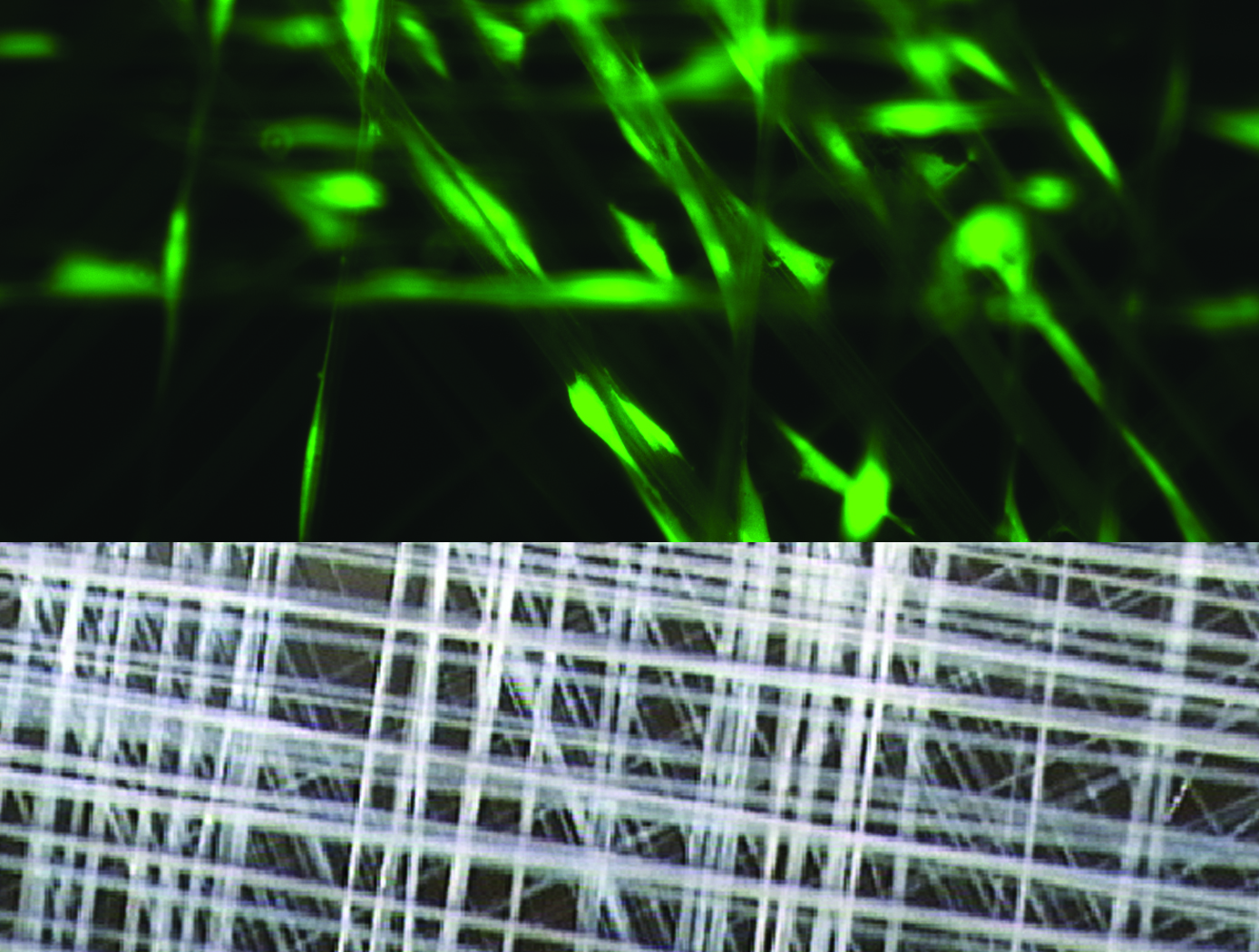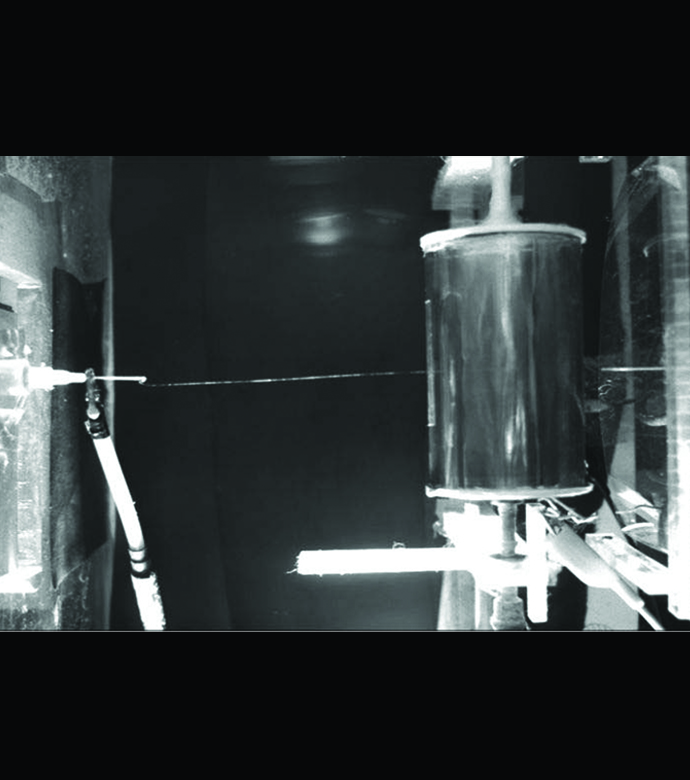Highly Aligned Electrospun Fibers and Mats
materials and coatings
Highly Aligned Electrospun Fibers and Mats (LAR-TOPS-2)
Incorporation of an auxiliary electrode for controlled micro- or nano-fiber placement, orientation, and porosity in electrospun mats
Overview
NASA's Langley Research Center has created a modified electrospinning apparatus for spinning highly aligned polymer fibers. Fiber placement, orientation, and porosity are difficult to control using conventional electrospinning apparatus. Conventional electrospinning creates randomly
oriented fibers that are well suited to nonwoven mats, but not to other applications. Now, NASA Langley has developed the capability to control the alignment and porosity of fibers for mats, which will broaden the range of engineering applications of electrospun materials to include new tissue
engineering scaffolds, membrane filters, textiles, and embedded sensors and actuators. The new apparatus provides a simple and inexpensive means of producing fibers and mats of controlled fiber diameter, porosity, and thickness.
The Technology
Electrospinning offers a versatile way to produce one-dimensional micro- or nanometer mats; however, electrospun fibers are typically collected in a random orientation, which limits their applications. NASA has developed a new apparatus that uses an auxiliary counter electrode to align fibers for control of the fiber distribution during the spinning process. The electrostatic force imposed by the auxiliary electrode creates a converged electric field, which affords control over the distribution of the fibers on the rotating collector surface.
The process begins when a pump slowly expels polymer solution through the tip of
the spinneret at a set flow rate as a positive charge is applied. The auxiliary electrode,
which is negatively charged, is positioned opposite the charged spinneret. The disparity
in charges creates an electric field that effectively controls the behavior of the polymer
jet as it is expelled from the spinneret; it ultimately controls the distribution of the
fibers and mats formed from the polymer solution as it lands on the rotating collection
mandrel. A broad range of fiber diameters can be manufactured by modifying various
parameters of the process and/or polymer solution. Performance data has confirmed
the substantial role that the electric field plays in the significant improvement in fiber
alignment and control relative to using the rotating collector alone.
Prototypes have been produced, and the repeatability of the process has been
confirmed. A patent application has been filed.


Benefits
- Consistency and control of: --Fiber distribution --Porosity --Fiber alignment
- Versatility: adaptable to micro and nano fiber sizes
- Repeatable results: amenable to mass production
- Capable of manufacturing single fibers
- Compatible with most polymer solution systems
- Inexpensive processing method
Applications
- Biomedical - tissue engineering scaffolds for cell formation; drug delivery; wound dressing; membranes
- Military - smart textiles and embedded sensors/actuators
- Filter applications - industrial, environmental, automotive
- Instrumentation - sensors for spectroscopy
- Chemical and biological sensors
- Fuel cells and solar cells
Similar Results

Electroactive Scaffold
Current scaffold designs and materials do not provide all of the appropriate cues necessary to mimic in-vivo conditions for tissue engineering and stem cell engineering applications. It has been hypothesized that many biomaterials, such as bone, muscle, brain and heart tissue exhibit piezoelectric and ferroelectric properties. Typical cell seeding environments incorporate biochemical cues and more recently mechanical stimuli, however, electrical cues have just recently been incorporated in standard in-vitro examinations. In order to develop their potential further, novel scaffolds are required to provide adequate cues in the in-vitro environment to direct stem cells to differentiate down controlled pathways or develop novel tissue constructs. This invention is for a scaffold that provides for such cues by mimicking the native biological environment, including biochemical, topographical, mechanical and electrical cues.

Miniaturized Electrospray System
NASA's miniaturized electrosprayer offers a new technology that may support the next generation of portable and/or of precise electrosprayers. Developed for applying water to plants in space where gravimetric methods do not apply, this sprayer may also enable the delivery of a precise liquid for terrestrial uses without relying on pressurized air.
Electrospraying (aka electrostatic spraying) is a technique where droplets are charged to enhance surface adhesion and coverage efficiency. Various electrospray variants are used in a host of industries to coat auto parts, apply pesticides and nutrients to crops, and more. Commercially-available electrosprayers are generally large, air-assisted devices that traverse up to 20 feet in the air and require large amounts of liquid and electrical power.
NASA's miniaturized electrosprayer system does not require compressed air, uses far less liquid, and concentrates the mist in an area less than 2 feet away. The system only needs enough power to charge the droplets at the spray nozzle, so it may use small batteries (e.g., AAA batteries). The new electrosprayer implements a unique nozzle design that imparts a high charge-to-mass ratio on the spray and increases coverage efficiency. Thus, the miniaturized electrosprayer can be placed inside a portable, handheld sprayer or be used as a stationary device for a wide range of uses, particularly when spraying expensive chemicals (e.g., plant nutrients) and when precise, efficient spraying is required (e.g., industrial coatings, disinfectants, etc.).

Conductive Polymer/Carbon Nanotube Structural Materials and Methods for Making Same
Carbon nanotubes (CNTs) show promise for multifunctional materials for a range of applications due to their outstanding combination of mechanical, electrical and thermal properties. However, these promising mechanical properties have not translated well to CNT nanocomposites fabricated by conventional methods due to the weak load transfer between tubes or tube bundles.
In this invention, the carbon nanotube forms such as sheets and yarns were modified by in-situ polymerization with polyaniline, a -conjugated conductive polymer. The resulting CNT nanocomposites were subsequently post-processed to improve mechanical properties by hot pressing and carbonization. A significant improvement of mechanical properties of the polyaniline/carbon nanotube nanocomposites was achieved through a combination of stretching, polymerization, hot pressing, and carbonization.

Polymer Cross-Linked Aerogels (X-Aerogels)
Researchers at NASA's Glenn Research Center have developed an approach to significantly improve the mechanical properties and durability of aerogels without adversely affecting their desirable properties. This approach involves coating conformally and cross-linking the individual skeletal aerogel nanoparticles with engineering polymers such as isocyanates, epoxies, polyimides, and polystyrene. The mechanism of cross-linking has been carefully investigated and is made possible by two reactions: a reaction between the cross-linker and the surface of the aerogel framework and a reaction propagated by the cross-linker with itself. By tailoring the aerogel surface chemistry, Glenn's approach accommodates a variety of different polymer cross-linkers, including isocyanates, acrylates, epoxies, polyimides, and polystyreneenabling customization for specific mission requirements. For example, polystyrene cross-linked aerogels are extremely hydrophobic, while polyimide versions can be used at higher temperatures. Recent work has led to the development of strong aerogels with better elastic properties, maintaining their shape even after repeated compression cycling. By tailoring the internal structure of the silica gels in combination with a polymer conformal coating, the aerogels may be dried at the ambient condition without supercritical fluid extraction.

Portable Slide Staining System for Microscopy
To stain a specimen slide, one or more liquid reagents are injected via the dispenser into the slide staining device via a syringe port. The volume of a given reagent is determined by adjustable settings on the dispenser, so that when connected to the staining device, initiates a thin film over the slide. The dispensing device uses only a fraction of the reagents typically used in non-sealed environments. Medical grade polyvinyl alcohol sponges have been incorporated into the dispenser to provide additional fluid containment and retention during the staining procedure. Furthermore, the dispenser can recall excess reagent, minimizing reagent use until refill.
The slide staining device is composed of an upper and lower section held together and aligned by use of Nd magnets. With the device open, a specimen slide is positioned upon a silicone gasket that sits within a recess in the lower section. When the device is closed, the silicone gasket in the upper section applies a seal to the slide forming a cavity that allows the slide to be exposed to reagents injected from the connected dispenser creating a stain through the use of capillary forces. Although originally designed for use in microgravity, the slide staining system also works in gravity environments.
Numerous applications may exist for this technology, particularly in hematology and cellular biology. Other applications could be considered for academic research, veterinary field use, military, disaster stricken and remote environments or where fine control of fluid delivery, removal, and management is desired.
The slide staining system is at technology readiness level (TRL) 8 (actual system completed and "flight qualified" through test and demonstration), and are now available to license. Please note that NASA does not manufacture products itself for commercial sale.



